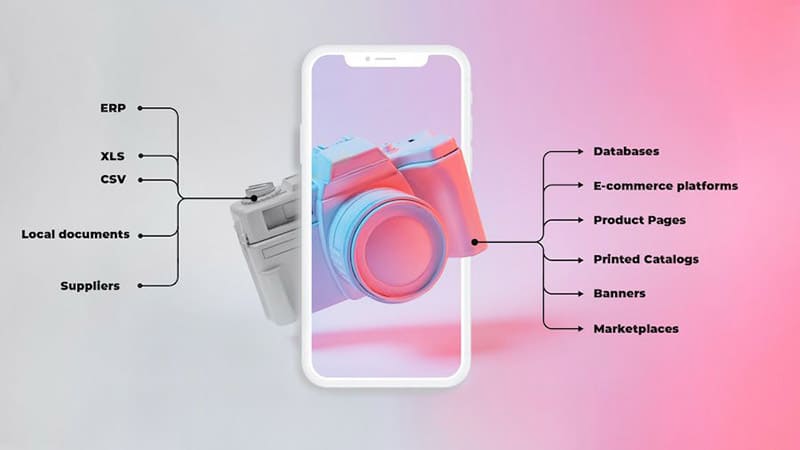5 Features You Should Look for in PIM Systems for B2B Purposes

It’s an exciting time to be an eCommerce manager in the B2B sector. Historically, the sector has been quite far behind its B2C counterpart, and users were willing to accept a certain level of jankiness and subpar experience. This, however, is changing rapidly.
Expectations are rising day by day, and business users are starting to demand experiences as smooth as those that they’re used to while B2C shopping in their free time. Reaching such a state is quite a challenge, but one with the potential to make a real positive impact and improve the experiences and business outcomes of all parties involved.
Product information management (PIM) systems have a key part to play in this transformative process. Getting the most out of collecting, managing, and distributing product information has a profound impact on the functionalities and overall quality of experience that B2B companies can offer via their eCommerce platforms.
So, what should you look for in a PIM system for such a purpose, keeping in mind the unique characteristics of B2B business models and processes? Let’s unpack this together throughout this article.
Product Data Quality and Governance
Although it’s not a universal rule, it’s safe to say that in most cases B2B buyers pay more attention to product data than in B2C shopping.
Simply put, B2C purchases are often a product of impulses and emotions, while B2B is all about carefully defined needs and precise parameters.
Complex Product Hierarchies and Relationships
Intricate product configurations and dependencies tend to be the backbone of B2B eCommerce. Corporate clients will rarely accept an off-the-shelf product that matches their requirements only in part; they’ll be looking for a complete fit.
A PIM system suited for this kind of environment should support advanced data modeling to manage complex product hierarchies, bundles, kits, and relationships, such as accessories, replacements, and alternatives.
This will ensure that all aspects of a product's configuration are accurately represented and easily navigable, and the clients are able to make precisely the purchases that they plan for.

Technical Data Management
B2B products often require detailed technical specifications, compliance documentation, and certifications. Because of this, data of both high quality and large quantity must be the backbone of effective product management.
Your PIM system should be able to handle extensive attribute sets and ensure that all relevant information, such as material composition, dimensions, performance data, and regulatory compliance, is accurately stored and accessible.
Data Cleansing and Version Control
On top of this, you should look for a PIM system that will be able to provide strong data validation, cleansing, and enrichment capabilities. These features help maintain data integrity and ensure that all product information is accurate, complete, and up-to-date.
Robust governance tools within the PIM are also a must. They can help set data standards and compliance guidelines to ensure adherence to industry regulations and internal policies. In such situations, advanced version control can become a lifesaver thanks to its ability to track changes to product information over time and ensure that historical records are preserved and auditable.
Multi-Channel Publishing
As digital touchpoints are slowly replacing the role of traditional sales representatives, it becomes clear that the future of B2B eCommerce is omnichannel.
This model simply fits into the landscape of modern business. The days of working exclusively from behind a desk at an office are gone, and, on top of this, certain steps of the procurement process go smoother through specific channels. B2B eCommerce needs to provide the flexibility that those new situations demand, and creating omnichannel experiences seems to be the best solution.
However, for an omnichannel model to work properly, you need to make sure that all the channels are provided with the right product information. This is not as straightforward as it might seem when you consider their different characteristics and needs.
Some channels might use all the different types of product data that you hold, others only a few of them, and some might need very specific data that’s used only in this particular channel, for instance, 3D files for AR experiences.

Image source: Unsplash
A lot can go wrong in such a spaghetti of data delivery, which emphasizes the need for a capable PIM system. It needs to enable you to distribute product information precisely and consistently across different sales channels, marketplaces, partners, and so on while accounting for the specific needs of each channel.
This will ensure a unified brand experience and make it possible to create a seamless omnichannel journey without the fear of important details getting lost along the way.
Workflows, Permissions, and Collaboration Tools
Provided that its scale is small enough, a B2C eCommerce store can usually be successfully managed by a single person. In other words, workload itself tends to be the deciding factor for how many people are involved in the process.
It’s quite a different story in the B2B setting: the processes are more complex by design and usually involve multiple participants, both on the vendor’s and the client’s sides. This can cause serious problems when a PIM solution isn’t built to handle various participants. When you can’t reliably recreate the company structure, workflows, and intricacies of access permissions in the system, it becomes practically useless, and you need to start taking shortcuts in your carefully planned processes.
For best results and a seamless setup, you should look for a solution that’s designed from the ground up to support such flexibility. Two functionalities are crucial here:
Role-Based Access Control (RBAC)
Various stakeholders, such as product managers, engineers, marketers, compliance officers, and more all require different access levels and permissions.
It’s crucial to get it just right. When they’re given too little autonomy, they can’t do their jobs effectively. On the other hand, if they get too much control, you risk that they modify the wrong types of data and compromise the integrity of the entire system.
This is the job of an RBAC module. It ensures that each user can access and modify data relevant to their role, with full regard to the unique limits and dependencies that you’ve established for your company.
No two B2B businesses are exactly alike, and your custom setup of an RBAC module is one of the key tools to reflect this.
Customizable Workflows
Differences between B2B businesses also manifest themselves in how their workflows are structured.
Data entry, validation, approval, and publishing are just a few examples of processes that happen in each PIM implementation but can look slightly different in each case.

Image source: Unsplash
This is why a PIM system for B2B purposes needs to give you as much freedom in customizing workflows as possible. It’s not only a matter of digitally recreating the processes that you’ve already established for your business; it also opens up the ability to automate, streamline tasks, and reduce bottlenecks throughout.
Pricing and Contract Management
One of the key features that differentiate B2B and B2C eCommerce is the individual approach, terms, and prices that are agreed upon with each client. Compared to the one-size-fits-all philosophy of B2C, this can completely stump a PIM system that isn’t built for such possibilities.
Hence, it becomes crucial to look for the ability to customize certain types of data and parts of business logic for each customer individually.
Contractual Information
The ability to integrate contract management features within the PIM is essential to streamline the handling of customer-specific agreements. These can include pricing terms, delivery schedules, and service level agreements (SLAs).
Such functionality ensures that all contractual obligations are adhered to, easily referenced, and automatically applied for all transactions.
Custom Pricing
In B2B eCommerce, prices are often negotiated individually while taking into account the specific relationship, historical purchases, and other unique factors for each customer. A PIM system must facilitate the creation and management of these personalized pricing agreements.
AI can play a large part here when used to its full potential, it can almost completely take over the process of calculating the optimal quote for each customer and applying it once approved. This will also be one of the main topics of an upcoming webinar hosted by Cloudflight AI experts.
You can find all the details and register here.
Tiered Pricing structures
On top of custom baseline prices for each customer, B2B transactions often involve tiered pricing based on volume, customer segment, and contract terms.
Therefore, a PIM system must support complex pricing models and allow for dynamic pricing adjustments and personalized offers.
Reporting and Analytics
Data-driven decision-making is as crucial in B2B operations as it is in any other modern business. A PIM system with powerful reporting and analytics capabilities can provide invaluable insights into product performance, data quality, and workflow efficiency. They can help you identify areas for improvement and are an integral part of making informed business decisions.
Unique Performance Metrics
That said, while metrics used in B2C eCommerce tend to be fairly universal, the B2B counterpart might rely on a much more custom and sophisticated set of data to collect and analyze.
On top of the usual eCommerce statistics, such as, for instance, average order value (AOV), conversion rate, and cart abandonment rate, there are also those unique to the B2B setting. They might include aspects like contract renewal rate, SLA compliance rate, payment collection cycle, and more.

Image source: Unsplash
Keeping all this in mind, while choosing a PIM system for your business, you should make sure that it’s either able to track the desired metrics straight out of the box or can be easily configured to do so.
Although some of the tracking will likely happen in other modules, the PIM system might still need to process these types of data in one way or another.
Customizable Dashboard
Collecting the data is just one piece of the puzzle, and making sense of it must follow. That’s where customizable dashboards come into play.
They’ll enable users to create tailored views of key performance indicators (KPIs) and other critical data points, ensure that each user has access to the most relevant information for their role, and, finally, enhance decision-making and operational efficiency.
Conclusion: Our PIM Pick for B2B Implementations
PIM systems for B2B eCommerce are a very different beast from their B2C counterparts. Because B2B workflows tend to be complex by design and unique to each business, an out-of-the-box solution won’t get you very far.
Instead, you should be looking for a system with a precisely defined set of features, such as those mentioned above, and one that provides as much flexibility and space for customization as possible. By focusing on these key aspects, you'll be able to find a PIM solution that not only meets your current needs but also supports your business growth and adapts to future challenges.
Given the collaborative nature of this article, it should come as no surprise that Cloudflight eCommerce experts lean toward Bluestone PIM as our go-to system for these kinds of implementations. It checks all the boxes discussed throughout the article and, thanks to its infrastructure based on the MACH architecture and its composable nature, provides just the right foundations for customization and extendability, which are all-important in the B2B setting.
B2B eCommerce is evolving rapidly, and we’re in a key period when some players will capitalize on it while others will sadly get left behind. If you’re thinking about setting up a powerful B2B eCommerce infrastructure with Bluestone PIM at its core, make sure to get in touch with us and ensure you’ll be among the former.




